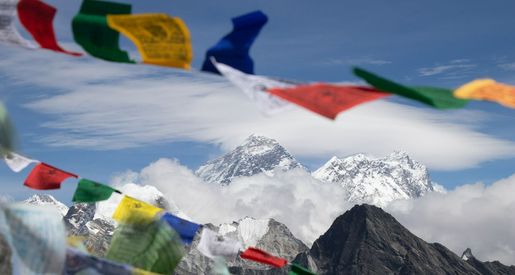- Details
- Category: Knowledge Centre
How to Train for the Everest Base Camp Trek
Training for Everest Base Camp shouldn’t be taken lightly but should also be fun. A combination of cardiovascular endurance, strength training, and hiking in the hills or mountains should be part of your preparation for the trek.
Nothing can truly prepare you for the altitude of 17,598 ft (5,364 metres ) or higher if you are doing the Everest Three Passes Trek but you can make your trek easier with proper training and reaching a fitness level capable of trekking with a pack on your back. That was my goal before beginning my first trek to Everest Base Camp.
My Training Regime
Before you start training - BUY YOUR BOOTS!
I can’t stress the importance of this enough. You want to have your boots broken in weeks or months before your trek. I wore mine every day and went on treks around the Brecon Beacons in Wales and even at the gym while I worked out.
Choosing a set of boots is really down to personal preference and what fits you. I went with the North Face Terra GORE-TEX® Mid Walking Boots.
I purchased these because a good friend wears them on hikes of 30-45 days. If they keep his feet dry and comfortable then they will keep yours dry and fit too. They were great boots and I highly recommend them. Any boot from North Face or Scarpa which are slightly more expensive are a good decision in my opinion.
Training program
When I am home I maintain a strength training program 3 times per week at the gym. This consists of compound lifts focusing on strengthening the entire body. I do not run or use the cardio equipment at all. Strength training is important for the Everest Base Camp trek but should not be your only focus. I had to add a few key exercises to my daily training to make sure my endurance was ready for the trek.
I trained roughly 8 weeks prior to my trek. I strength train year-round so these 8 weeks were only the addition of cardio training. I would recommend 12-16 weeks if you aren’t already hitting the gym regularly. I know I could have used a few extra weeks training on hills and trails before the trek to reduce fatigue on uphill climbs.
(Keep in mind this is just a recommendation of my personal training and you should consult a physical trainer or your doctor before following any of my tips)
How to Train for the Everest Base Camp Trek
Key Exercises
I maintained my current strength routine at the gym but added a few other exercises that would help for the trek. You do not need to train for Everest Base Camp with these lifts. These are just a part of my current and on-going routine. However, strengthening your legs is a great way to improve your trekking performance.
My workouts included:
- Dead lifts
- Squats
- Front Squats
- Bench Press
- Incline Press
- Pull-ups
- Push-ups
- Weighted step-ups
- Many other various lifts
My strength routine lasts 45-60 minutes per day. Adding an additional 30 minutes of training dedicated to CV training daily in addition to strength training would be highly beneficial.
You don’t need to add any of these lifts to your routine but strengthening your legs is a good idea.
Cardiovascular Training for Base Camp
Any type of cardiovascular conditioning is good training for Everest Base Camp. Your days will be spent walking rolling hills with a weighted pack and a few litres of water. A couple of days will be spent on tough uphills so the more training the better.
I never woke up massively sore after a long day of trekking but there were days when the uphill sections felt exhausting. Shortness of breath at altitude was the toughest thing to train for. It was a feeling I had never felt but the key was taking it slow, drinking plenty of water to keep hydrated and enjoy the surroundings. It’s one of the most beautiful places on the planet so take your time and take plenty of photos.
I recommend walking in the mountains or hills if you can get access to them prior to the trip. Also walking inclines on the treadmill with a weight vest is a great way to start. This is a low-impact exercise and a great way to start your training. Eventually, if you can add the stair climber to your routine you will notice the difference when walking generally and walking uphill. Wearing a weighted vest will simulate your day pack and a good way to build endurance. I recommend that if you do purchase a weight vest that it weighs more than your full day pack so 7-10kg. This way the day pack will seem lighter by comparison when you are on the trek.
Running, rowing, cycling, swimming, and walking uphills are all a great way to build your endurance. Mix it up and choose the exercise you enjoy the most. My goal was to simulate the trek as closely as possible and walking in the hills getting the leg muscles ready is in my opinion the ideal training method.
Next Level Training
If you want to take your training up a notch buy one of these:
Elevation Training Mask High Altitude Simulation
or a slightly discounted version Power Breath Sports Performance Plus
Yes, you are going to look like Bane at home or in the gym but it just might help you get ready for the altitude. This mask helps with:
- Increased lung capacity
- Increased Mental and physical stamina increase
- Increased Mental Focus gets better
- Increased oxygen efficiency
- Increased energy Production
I can tell you from experience, using a mask like this made my workouts a lot more difficult. I wore it a few times a week just at home, then doing pull-ups, push-ups, and uphill walk.
I made it to Everest Base Camp but I can’t say there is any correlation between using this mask and not having any serious problems at altitude. That said i didn't suffer any altitude issues.
Trekking Conditioning for Base Camp
The best way to train for a trek is to do some actual trekking. If you are fortunate enough to live in a place with hiking trails nearby there is no better way to train. Lace up your boots, strap on your pack, and hit the trails or the mountains. Mix these hikes in with your strength and conditioning routines and fully prepare yourself for the trek.
Altitude Training for Base Camp
Unless you live at altitude there is no way to truly train for this. You can use the altitude mask to simulate your lung capacity and stamina but you can’t properly train your body at sea level for high altitude trekking.
The best thing you can do is get in the best physical shape you can before you go. Your body will naturally adjust as you trek to Base Camp but the key is to walk slowly even when your body can push you further. The supposedly fittest athletes are often the ones who walk too quickly each day and as a result of this, feel the symptoms of altitude sickness instead of taking it easy.
So our suggestion - Train hard. Trek slow and enjoy the journey of a lifetime.
Previous Articles
- How to Train for the Everest Base Camp Trek
- How high is Everest Base Camp?
- How much spending money do you need for the Everest Base Camp trek
- What's the accommodation like on an Everest Base Camp trek
- Are showers available on the Everest Base Camp trek?
- What type of toilets are available on an Everest Base Camp Trek



